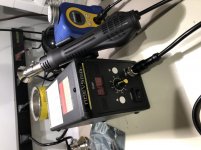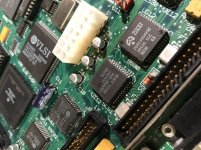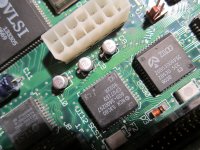-
Updated 2023-07-12: Hello, Guest! Welcome back, and be sure to check out this follow-up post about our outage a week or so ago.
You are using an out of date browser. It may not display this or other websites correctly.
You should upgrade or use an alternative browser.
You should upgrade or use an alternative browser.
SE/30 Logic Board Resurrection
- Thread starter LaPorta
- Start date
LaPorta
Well-known member
Bolle I’m trying...it’s so tedious I can’t do much st a time. So far they all seem to be working well. I wonder if something else is wrong not involving traces. I may shelve this for a while; I’m going mad.
i also can’t find page 9 of the schematics online, and multiple VIA traces go there. Any ideas?
i also can’t find page 9 of the schematics online, and multiple VIA traces go there. Any ideas?
LaPorta
Well-known member
I'll re-check, because unless the resolution is so poor that I can't amke things out properly, some of the traces off the page for the VIAs lists "9" as where they go.
EDIT: In fact, I just checked, and on page 4, sure enough, there are Pins from the VIAs that specify that they go to 9. Perhaps this means something else.
EDIT: In fact, I just checked, and on page 4, sure enough, there are Pins from the VIAs that specify that they go to 9. Perhaps this means something else.
Last edited by a moderator:
LaPorta
Well-known member
Ok, to resurrect this thread, I just received three SCSI chips I ordered from eBay. One thing I did not mention is that, at least 18-19 years ago, I replaced this motherboard in my SE/30 for a new one because it just stopped working. At that point, the capacitors were not really leaking on any of my machines that badly. If my fuzzy memory serves, I may have pulled off a SCSI device while the machine was on, possibly taking out the SCSI chip. I would like to replace the chip to verify and see if it really is the chip. However, I have no hot air station. I have pretty good hot iron skills, and I was wondering if it is possible to use solder wick to suck out each traces solder and remove the chip. Tedious, but I would do it. If you guys really don't recommend it, I guess I'll bite the bullet and get the hot air station.
davidg5678
Well-known member
I have been able to remove surface mount ICs with just my soldering iron before, but I wouldn't really recommend it. On several occasions where I have tried this, several pads ended up tearing from the PCB. I now use one of the cheap 858D hot air stations, and I have had much better luck removing ICs with it instead. It took me a fair bit of practice to get the hang of using the hot air station, but once I figured out what I was doing, I had far greater success.I have pretty good hot iron skills, and I was wondering if it is possible to use solder wick to suck out each traces solder and remove the chip. Tedious, but I would do it. If you guys really don't recommend it, I guess I'll bite the bullet and get the hot air station.
I'd recommend watching several tutorials and practicing on a junk board before trying to do anything to your SE/30 -it can be very easy to melt things by mistake and accidentally cause new problems.
Good luck!
You can use a low melting point solder with a standard Iron. You apply on all 4 sides and then drag the iron around until the chip is removed. Be sure to clean it all when done. Here is an example:
https://www.amazon.com/ChipQuik-SMD1-Leaded-Temperature-Removal/dp/B0019UZP7I/ref=sxin_3_ac_d_rm?ac_md=0-0-Y2hpcHF1aWs%3D-ac_d_rm&cv_ct_cx=chipquik&keywords=chipquik&pd_rd_i=B0019UZP7I&pd_rd_r=1eb8e2c0-e803-45af-b29e-f773585e1944&pd_rd_w=UqDMY&pd_rd_wg=SaV69&pf_rd_p=6d29ef56-fc35-411a-8a8e-7114f01518f7&pf_rd_r=P6753YN02TX46A5N9YX2&psc=1&qid=1578818865
https://www.amazon.com/ChipQuik-SMD1-Leaded-Temperature-Removal/dp/B0019UZP7I/ref=sxin_3_ac_d_rm?ac_md=0-0-Y2hpcHF1aWs%3D-ac_d_rm&cv_ct_cx=chipquik&keywords=chipquik&pd_rd_i=B0019UZP7I&pd_rd_r=1eb8e2c0-e803-45af-b29e-f773585e1944&pd_rd_w=UqDMY&pd_rd_wg=SaV69&pf_rd_p=6d29ef56-fc35-411a-8a8e-7114f01518f7&pf_rd_r=P6753YN02TX46A5N9YX2&psc=1&qid=1578818865
superjer2000
Well-known member
This! I use ChipQuik all the time to remove SMD ICs and it works great. I’ve never lifted a pad.You can use a low melting point solder with a standard Iron. You apply on all 4 sides and then drag the iron around until the chip is removed. Be sure to clean it all when done. Here is an example:
https://www.amazon.com/ChipQuik-SMD1-Leaded-Temperature-Removal/dp/B0019UZP7I/ref=sxin_3_ac_d_rm?ac_md=0-0-Y2hpcHF1aWs%3D-ac_d_rm&cv_ct_cx=chipquik&keywords=chipquik&pd_rd_i=B0019UZP7I&pd_rd_r=1eb8e2c0-e803-45af-b29e-f773585e1944&pd_rd_w=UqDMY&pd_rd_wg=SaV69&pf_rd_p=6d29ef56-fc35-411a-8a8e-7114f01518f7&pf_rd_r=P6753YN02TX46A5N9YX2&psc=1&qid=1578818865
davidg5678
Well-known member
I use a very cheap 858D hot air station. (There is not an attached soldering iron) It looks like they cost about $40USD online right now.
From what I have read online though, it looks like there is a wide range of quality control depending on which seller you purchase from. The first thing I did when my unit arrived was to take it apart and make sure that it was wired correctly. (I was lucky enough not to have any issues with my hot air station) There are many videos online explaining what to check for and potentially change in the wiring so that the circuitry works safely and does not start a fire. I think I used this one: https://www.youtube.com/watch?v=pgR7YbXUivs
Other than the potential for safety issues, (which can be easily fixed if there are any) I have had fairly good luck with my station and I've used it to desolder at least a dozen components from my battery damaged Mac Classic's motherboard alone.
From what I have read online though, it looks like there is a wide range of quality control depending on which seller you purchase from. The first thing I did when my unit arrived was to take it apart and make sure that it was wired correctly. (I was lucky enough not to have any issues with my hot air station) There are many videos online explaining what to check for and potentially change in the wiring so that the circuitry works safely and does not start a fire. I think I used this one: https://www.youtube.com/watch?v=pgR7YbXUivs
Other than the potential for safety issues, (which can be easily fixed if there are any) I have had fairly good luck with my station and I've used it to desolder at least a dozen components from my battery damaged Mac Classic's motherboard alone.
LaPorta
Well-known member
Update: I got the 858 iron as well as nozzle for the chip. Nice little package. Worked well too. I’d say the replacement was not so bad as far as my first try with removal and then resolder with regular iron:

I fries the SCSI connector plastic a bit: will learn next time to cover it with foil or something.
The positive is this: the machine now starts from a floppy! The old chip must have indeed been fried from past carelessness. However, I can not locate the internal drive in the bus, and it worked the last time I had this thing fired up. There may yet be some kind of issue, I wonder where to look next...


I fries the SCSI connector plastic a bit: will learn next time to cover it with foil or something.
The positive is this: the machine now starts from a floppy! The old chip must have indeed been fried from past carelessness. However, I can not locate the internal drive in the bus, and it worked the last time I had this thing fired up. There may yet be some kind of issue, I wonder where to look next...
LaPorta
Well-known member
I tried this morning with a known-good SCSI HD, to no avail. Using Apple HD SC Setup from a floppy freezes the machine. There must be some other error somewhere (diode, resistor, etc) along the chain that is likely causing something, but I don't know where that might be. I'll look at the schematics and see if there is anything obvious.
Suggestions always taken, as usual.
Also, is it rather easy to get replacement 50-pin SCSI headers if you really mangle them with heat?
Suggestions always taken, as usual.
Also, is it rather easy to get replacement 50-pin SCSI headers if you really mangle them with heat?
Bolle
Well-known member
Might still be a bad trace.
What traces did you check in the beginning? Everything that comes and goes to the SCSI chip?
Also make sure all your soldered connections are good.
Most of the time when it does the no :?: thing it is one of the data bus data lines that’s not connected to the chip.
When one of the SCSI data lines is broken you get the HDD light flashing at the same rate as the :?:
What traces did you check in the beginning? Everything that comes and goes to the SCSI chip?
Also make sure all your soldered connections are good.
Most of the time when it does the no :?: thing it is one of the data bus data lines that’s not connected to the chip.
When one of the SCSI data lines is broken you get the HDD light flashing at the same rate as the :?:
Last edited by a moderator:
LaPorta
Well-known member
To be more specific, Bolle, it originally had the gray raster and no question mark problem. Now that I replaced the SCSI chip, the question mark comes up normally, and I can boot with a floppy, no issue. So, in effect, the SCSI chip works now as the machine can communicate with it...but SCSI itself is not working properly.
LaPorta
Well-known member
Small update: located one pin (SCSI Chip 32) which was not connecting with the corresponding pin on the SCSI drive cable header pin. Patched and bypassed it, but still no go. On the hunt for further problems!
I also tested and verified F2 and D3 as I noticed they play into supplying the 5V for the port. All test good.
I also tested and verified F2 and D3 as I noticed they play into supplying the 5V for the port. All test good.
LaPorta
Well-known member
It now works!
I removed the SCSI chip and cleaned up all the traces. Every last one tested good. I also ordered solder paste to use with the hot air station. After watching a video, it took me a good hour to get it in place and get rid of a number of solder bridges (the last tenacious one took half of that hour). Fired it up, and it immediately started from the internal HD. Seems my memory was correct: about 20 years ago I blew the SCSI chip by removing an external HD while the machine was on. Good thing I saved the board instead of tossing it then. I replaced it with one from eBay (which was probably all
of $5-10 in 2000). This one sat on my shelf collecting dust as a display. Now one more SE/30 board out there is again working! Just needs a re-cap to be complete.
I removed the SCSI chip and cleaned up all the traces. Every last one tested good. I also ordered solder paste to use with the hot air station. After watching a video, it took me a good hour to get it in place and get rid of a number of solder bridges (the last tenacious one took half of that hour). Fired it up, and it immediately started from the internal HD. Seems my memory was correct: about 20 years ago I blew the SCSI chip by removing an external HD while the machine was on. Good thing I saved the board instead of tossing it then. I replaced it with one from eBay (which was probably all
of $5-10 in 2000). This one sat on my shelf collecting dust as a display. Now one more SE/30 board out there is again working! Just needs a re-cap to be complete.
Similar threads
- Replies
- 23
- Views
- 2K
- Replies
- 4
- Views
- 197
- Replies
- 2
- Views
- 328

